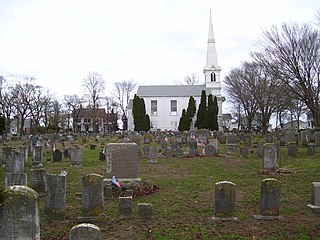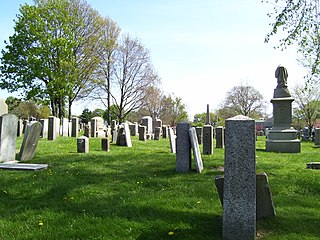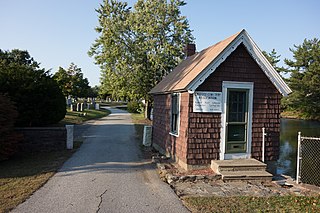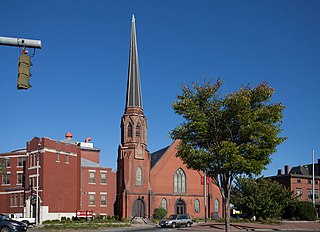
Little Compton is a coastal town in Newport County, Rhode Island, bounded on the south by the Atlantic Ocean, on the west by the Sakonnet River, on the north by the town of Tiverton, and on the east by the town of Westport, Massachusetts. The population was 3,616 at the 2020 census.
Thomas Willett was a Plymouth Colony fur trader, merchant, land purchaser and developer, Captain of the Plymouth Colony militia, Magistrate of the colony, and was the 1st and 3rd Mayor of New York, prior to the consolidation of the five boroughs into the City of New York in 1898.

Riverside is a neighborhood in the city of East Providence in the U.S. state of Rhode Island. Despite not being an incorporated city, Riverside has its own zip code, 02915, and is an acceptable mailing address according to the United States Postal Service. Riverside has a population of approximately 20,000 people.

Rumford is the northern section of the city of East Providence, Rhode Island, USA. The Rumford section of East Providence borders Seekonk, Massachusetts, Pawtucket, Rhode Island and the Ten Mile River. Rumford has been part of three towns and two states: Rehoboth, Massachusetts, Seekonk and East Providence, Rhode Island. It became part of Rhode Island in 1862. Rumford Baking Powder was made in the town at the Rumford Chemical Works and was named after Sir Benjamin Thompson, Count Rumford.

Swan Point Cemetery is a historic rural cemetery located in Providence, Rhode Island, United States. Established in 1846 on a 60-acre (0.24 km2) plot of land, it has approximately 40,000 interments.

The Old Burying Ground is a historic cemetery in Halifax, Nova Scotia, Canada. It is located at the intersection of Barrington Street and Spring Garden Road in Downtown Halifax.

The Smithfield Friends Meeting House, Parsonage and Cemetery, is a Friends Meeting House of the Religious Society of Friends (Quakers), rebuilt in 1881. It is located at 108 Smithfield Road in Woonsocket, Rhode Island. The meetinghouse is home to one of the oldest Quaker communities in the region.

The Common Burying Ground and Island Cemetery are a pair of separate cemeteries on Farewell and Warner Street in Newport, Rhode Island. Together they contain over 5,000 graves, including a colonial-era slave cemetery and Jewish graves. The pair of cemeteries was added to the National Register of Historic Places as a single listing in 1974.

The Clement Weaver–Daniel Howland House is a historic stone-ender timber frame house built in 1679. This rare example of primitive 17th-century architecture is located at 125 Howland Road in East Greenwich, Rhode Island. It is the oldest documented dwelling house in Kent County and the second oldest home in Rhode Island.

The Carpenter, Lakeside, and Springvale Cemeteries are historic cemeteries located on Newman and Pawtucket Avenues in East Providence, Rhode Island, United States. The three cemeteries occupy a triangular area bounded by Newman and Pawtucket Avenues to the east and south, and railroad tracks to the west. Carpenter Cemetery, the oldest, was established in 1844. Springvale was established in 1888 and Lakeside in 1895. The area is one of the few remaining undeveloped areas of what was once a "ring of green" around the historic center of Rehoboth, which was near this area.

The Newman Cemetery is an historic cemetery in East Providence, Rhode Island. One of the oldest in the state, the cemetery was established in 1643, when the area was part of Rehoboth, Massachusetts. It is located at the southwest corner of Newman and Pawtucket Avenues, adjacent to the Newman Congregational Church. Its first recorded burial is in 1658, and it remained in use well into the 19th century.

Grace Church is an historic Episcopal church at 300 Westminster Street at Mathewson Street in downtown Providence, Rhode Island. It was built in 1845-46 and was designed by Richard Upjohn in the Gothic Revival style.

The Trinity Square Historic District is a historic district in the Elmwood neighborhood of Providence, Rhode Island. It includes four properties on the south and west side of Trinity Square, the triangular junction of Elmwood Avenue and Broad Street. The visual focal points of the district are the Grace Church Cemetery, which is located south of the square, and the Trinity United Methodist Church, an imposing Gothic Revival structure built in the mid-1860s to a design by Clifton A. Hall. North of the church stands the Clifton Hall Duplex, designed and occupied by Hall, and the James Potter House, an elaborate Queen Anne mansion built c. 1889 and designed by Stone, Carpenter & Willson.

The Ancient Burying Ground is a historical cemetery at Phinney's Lane in Barnstable, Massachusetts. It is the oldest cemetery in the village of Centerville, and the only surviving civic element of its colonial origins. was listed on the National Register of Historic Places in 1987.

The East Main Street Cemetery is a historic cemetery on East Main Street in Dalton, Massachusetts. The cemetery is one of the oldest in the town, with grave markers dating to the 1780s. It was founded on land owned by the Chamberlin family, whose identified graves make up about 20 percent of roughly 250 gravesites. The cemetery was listed on the National Register of Historic Places in 2000.

The Myles Standish Burial Ground in Duxbury, Massachusetts is, according to the American Cemetery Association, the oldest maintained cemetery in the United States.

The Clifton Burying Ground is an early colonial cemetery located in Newport, Rhode Island, United States. It is a Quaker cemetery, and has the graves of four Rhode Island colonial governors.

The Old Churchyard Cemetery is a historic cemetery on Jenks Road in Cheshire. It is one of Cheshire's oldest cemeteries, and is located near the site of the first Baptist meetinghouse in the town.
Long Plain Cemetery is a historic cemetery at 19 Depot Road in Leverett, Massachusetts. The 1-acre (0.40 ha) cemetery is located on the south side of the street about 1.5 miles (2.4 km) west of Leverett center. The cemetery, whose oldest documented burials date to 1781, was listed on the National Register of Historic Places in 2020. Its burials include some of the town's early residents, and it remains in active use.
Prince Greene, was a Black violinist who lived in 18th century Rhode Island. In 1777, while he was enslaved to Richard Greene, he enlisted as a Private in the 1st Rhode Island Regiment to pursue his freedom in the Continental Army during the American Revolution. In 1781, while an active duty soldier, Greene was court-martialed for an incident that resulted in the death of Edward Allen, a white civilian. Also an active musician, in the early decades of the 1800s, he would play the fiddle for private parties in East Greenwich, Rhode Island.





















